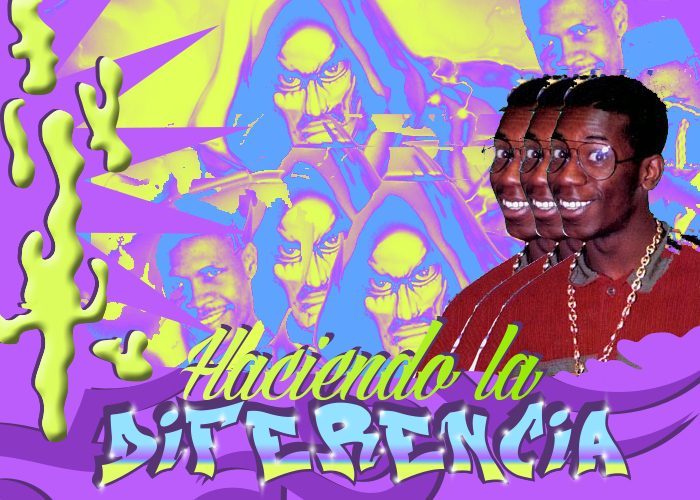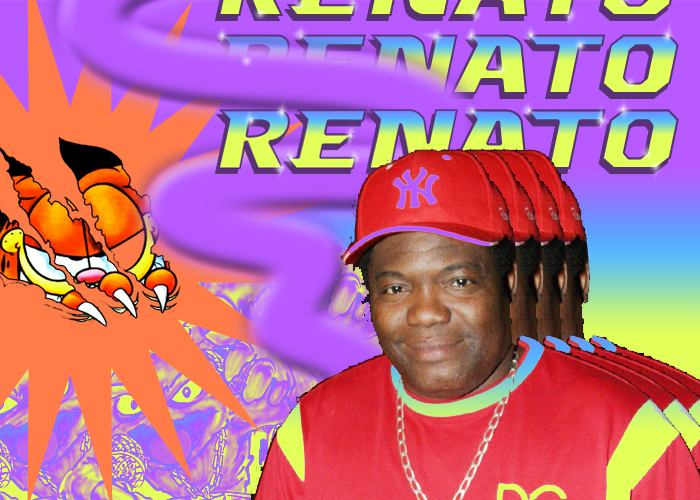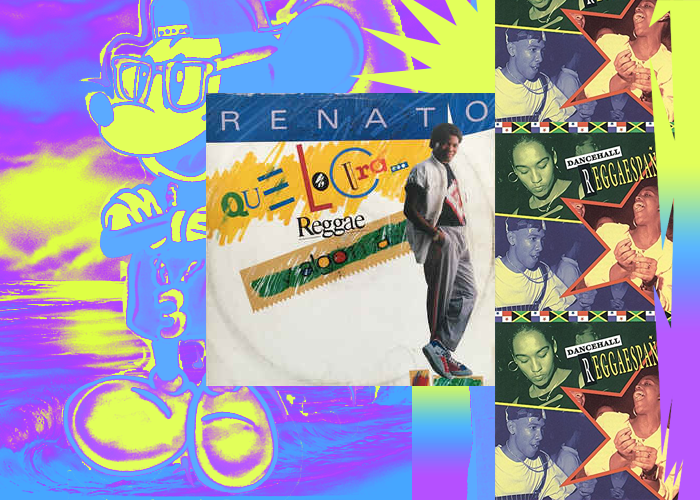Reggaeton began organically as a transformation of dancehall, hip-hop, and reggae en español. As an Afro-diasporic movement, Panama, Puerto Rico, Jamaica, the Dominican Republic, and New York are all pivotal landscapes in the style’s musical evolution. Through Tu Pum Pum: The Story of Reggaeton, a new column by Eddie Cepeda, we’ll explore reggaeton’s history, sociopolitical struggles, and its impact as a global force in music and culture.
In 1904, the U.S. took over the fledgling Panama Canal project the French had recently abandoned. Over 100,000 West Indian immigrants brought the project to fruition. This mass Antillean migration changed the cultural fabric of Panama forever. Even though they were the lifeblood of the project, the workers faced rampant discrimination and systemic segregation. And while many of their children were born in the Canal Zone, raised with U.S. customs, and spoke English, they were explicitly denied U.S. citizenship, while the Panamanian government made the naturalization process onerous and rare. It wasn’t until the 1977 Torrijos-Carter Treaties saw the U.S. give the Canal Zone back to Panama that a full integration with Latin American culture took place on the isthmus. It was then, on the Diablo Rojo buses of Panama City, that a dancehall-derived sound took shape and began to spread across the country and beyond, making Panama the hotly contested birthplace of reggaeton.
“El reggaetón es panameño, y no porque yo digo, ¡sino porque es así!” revered salsero Rubén Blades once proclaimed. This surely ruffled some feathers, as many have long argued that the maze to reggaeton’s inception leads to Puerto Rico. Many Panamanians – and reggaeton experts – dispute that, contending their country is the native mother of the genre.
Pioneers like El General and Renato claim to be the spark that ignited this musical revolution, while some vehemently dismiss Panamanian plena as nothing more than faithful covers of Jamaican dancehall. But even the origin of the word “reggaeton” is up for debate.
“Michael Ellis [the Panamanian producer responsible for much of El General’s early work, among others] used to say, ‘We gotta do a big reggae, like a reggae-ton,’” Renato tells Remezcla in a phone interview. Panamanian plena singer Jaime Davidson, better known as Gringo, El Original agrees. In a 2010 interview with Mi Diario from his prison cell, Davidson said, “[Michael Ellis said] to make the word big. And like everything big [in Spanish] we add ‘on’ like cabezón or camisón, so we called it ‘reggaeton,’ a big ‘reggae.’ That’s the plain truth.”

But no matter what side of the issue one is on, there’s no denying that the transculturation that took place in Panama — and later filtered through New York, and other key sites — is responsible for an influential collision of sounds that helped inform what we now know as reggaeton. Whether Panamanians invented the genre or not, their interpretation of Jamaican dancehall is more pivotal to reggaeton’s history than has been given credit. And in part, it begins with public transportation.
Diablos Rojos and the Birth of Plena
In the late 70s, dozens of retrofitted American school buses painted with a kaleidoscopic range of electric shades and reverberating with loud dancehall basslines, sped dangerously down the streets of Panama City. The buses, known as Diablos Rojos, were part of a fiercely competitive, private transportation system that rewarded drivers for luring the most commuters.
Five young rastafarians boarded one of the buses that regularly stopped in Panama City’s traditionally West Indian Río Abajo neighborhood, and handed the driver a cassette. Some of the music was custom-written for the driver, who paid the young dreadlocked men to write songs extolling his virtues — not just as a motorist, but also as a lover, and all-around badass — hoping to attract more customers. Little did the passengers know their often-dangerous commute home was the stage for the genesis of a genre.
“El reggaetón es panameño, y no porque yo digo, ¡sino porque es así!”
The young men sang and improvised over the Jamaican “versions” and riddims blasting from the cassette – first in Jamaican Patois in their early days, and later in Spanish, when demand grew. The young men, then known as Parliament Pacific Stars, put on a stellar show. One of the “stars,” Edgardo Franco, was a prolific improviser. His natural, calypso-derived talent for improvisation landed him the nickname El General. He’d eventually spread the gospel of Panamanian plena, or reggae en español, to the far reaches of the globe. But before he had a chance to regale Madison Square Garden with “Robi Rob’s Boriqua Anthem,” he got his start singing on these now-extinct city buses – a hair-raising form of transportation, and one of the birthplaces of reggaeton.
Renato and Franquito
Another member of the Parliament Pacific Stars who’d board the Diablos Rojos to perform, Leonardo Renato Aulder, is one of the most important figures in the creation of reggae en español. In a recent phone conversation from Panama, he told Remezcla, “People always wanna find out who [invented] the TV, who [invented] the telephone, who [invented] the microwave. You know you gotta know history. If you don’t know history, you’re fucked up.”

In the early 80s, radio DJ Hector Tuñón found a copy of Renato’s song “Que Es lo Que El D.E.N.I. Puede Hacer?,” often referred to simply as “El D.E.N.I.,” and helped spread it on Panamanian radio. “It got so big people started calling my boss saying, ‘Hey, we wanna order 800 copies of El D.E.N.I.’ and my boss was like ‘What?’” Renato recalls. “He rushed and we did a tape and did a 45, and it was big hit in Panama. Nobody else was doing that style yet.”
“I used to sing in English and I tried to sing like the Jamaicans,” Renato recalls. Later, at the behest of his mentor, Panamanian DJ Wassa Banga (sometimes spelled Guasabanga), the budding selector and singer made the full transition to Spanish. “I didn’t know how to speak Spanish ‘cause I came from the Canal Zone. That song, ‘La Chica [De Los Ojos Cafe]’, [on] that song, I said, ‘Ohhhs cafe.’ I didn’t pronounce ‘ojos’ [the] right way, know what I’m saying?”
But even Renato’s budding success and influence across Latin America paled in comparison to the mountainous rise of his good friend “Franquito,” (as Renato refers to him) otherwise known as El General.
Edgardo Franco, like Renato, got his start on the Diablo Rojo buses of Panama. But success came much later for him, after a move and a career change. According to an interview with Christopher Twickel from the 2009 anthology Reggaeton, in 1985, Franco moved to New York to pursue a degree in business administration. At the behest of his brother-in-law, Panamanian rapper Nando Boom, he made a move back into music, but mostly as a hobby. With the money from his professional job, he purchased the equipment to form his mobile DJ setup, Bachelor Sound. “I did parties, just like I would do in Panama. When I would do it in Spanish, I would see a stronger reaction. That was why I decided to record in Spanish instead of Patois,” he said.
His first Spanish-language single, “Tu Pun Pun,” was a hit on American radio, catapulted by the mixture of Anglo and Latino audiences he performed for in New York. Working with influential producers like Erik Morillo and C+C Music Factory broadened El General’s reach across genres, cultures, and fan bases. Hits like “Muevelo,” “Te Ves Buena,” “Rica y Apretadita,” and a collaboration with C+C Music Factory, “Robi-Rob’s Boriqua Anthem” are now history.

Even with all the tours and accolades, Renato claims El General didn’t fully understand the scope of his own popularity and importance. “Franquito didn’t know what he was doing,” Renato exclaims. “El General didn’t know la importancia, osea, we [Renato, Nando Boom, etc.] was great hit in Sudamerica and stuff, but El General was [a] hit in [the] United States!” he says, almost still in disbelief. And it’s El General’s global visibility that many believe led Puerto Rican rappers like Vico C to incorporate dancehall riddims into the already popular “underground” music of the caseríos.
Why did most of the Panamanian pioneers of the genre get left behind when reggaeton’s explosion came?
The Transformation of Dembow
El General’s resounding success often overshadows another often overlooked element in the conversation of reggaeton’s beginning — the subtle yet far-reaching influence of Nando Boom’s “Ellos Benia (Dem Bow).” A mostly exacting cover of Jamaican dancehall artist Shabba Ranks’s 1991 single “Dem Bow,” the ingenious yet understated changes on Boom’s version helped shape reggaeton’s “Dembow” riddim forever.
As Wayne Marshall meticulously unpacked in his essay for Red Bull Music Academy about the history of the dembow loop, the version re-recorded by Dennis “The Menace” Thompson for Boom’s version added digital timbales and fetching accents at the behest of Boom’s manager Pucho Bustamante. This instrumental, known as “Dub Mix II,” took the reinterpretation of dancehall to the next level, and a quick side-by-side comparison compiled by Marshall allows one to hear its transformation from dancehall classic to reggaeton’s driving force.
The instrumental “Dub Mix II” was later added as the b-side of Bobo General and Smiley Wonder’s “Pounder,” making it instantly accessible for use by other aspiring rappers, and cementing its spread in Puerto Rican underground music.
Today, these more traditionally dancehall-inspired beats are making their way back via songs like Daddy Yankee’s “Dura,” or even Ozuna and Cardi B’s “La Modelo.” A sort of blurring of the lines between pop-dancehall and reggaeton seems to be on the horizon. But a style that more closely echoes the early days of Panamanian plena can be found in the stripped-down production approach of Dominican dembow, with some artists like Bulin 47 leading the charge (to be sure, the two styles differ sonically in many ways).
The Force of Colorism
So why did most of the Panamanian pioneers of the genre get left behind when reggaeton’s explosion came? Some, like Renato, chalk it up to lack of investment, and more specifically, colorism. “The stations didn’t wanna play our songs ‘cause they were like, ‘No this is black music. Maleante.’ They [Puerto Rican artists] had people invest in these guys. Nadie invirtió en nosotros. Ellos tuvieron todo… they were white(r), they looked good, they dressed good. And we were black from Panama City. People were like, ‘This image looks beautiful, and this image looks mas o menos; let me go with the white(r) guys,’ and that’s what happened.”
Regardless, he insists he has nothing but love for the Puerto Rican artists he calls his friends. “Hicieron una industria con esta música y los felicito,” he tells me. “People say ‘Are you angry ‘cause you didn’t make no money?’ I say ‘No,’ but I want my recognition.”
Ultimately, that recognition may never fully come. But reggaeton’s roots – cemented in reggae, dancehall, and calypso, and interpreted by Antillean diaspora in Panama – are undeniable. Panama’s long history of colonialism and exploitation of West Indian workers in a U.S.-controlled zone led to a unique deciphering and melding of cultures. Privatized public transportation created the Diablo Rojos, and gave aspiring artists a literal vehicle for the shaping of their craft. El General’s success in New York, and later globally, further propelled the sound to new heights.
Reggaeton’s story transcends popularity and chart performance. It’s not about “Gasolina” or “Despacito,” or even about “Muevelo.” It’s about the indoctrination of our community, and the false belief that identity can be collapsed into something as simple as “reggaeton Latino.” As reggaeton continues to grow, a thorough look into its underappreciated creators peels back layers that many would rather ignore. Reggaeton forces us to look at both the good and the bad of our history. And most importantly, it makes us wonder who the Renatos of today could be – marginalized innovators grinding away in their own Diablos Rojos.
Stream a playlist featuring these Panamanian artists and more via Spotify or Apple Music:







